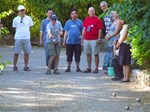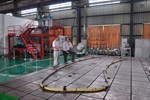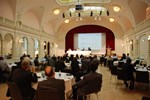On 20-21 August, several meetings took place in Rokkasho, Japan, between the CODAC teams in charge of the machine protection and interlocks of ITER and the International Fusion Materials Irradiation Facility (IFMIF) team.
IFMIF is one of the projects of the Broader Approach agreement between Japan and Europe, which was signed to support ITER and achieve an early realization of fusion energy for peaceful purposes. In particular, IFMIF must present results in parallel with ITER operation since these will allow the design of DEMO by qualifying the materials capable of withstanding the neutron flux that a commercial nuclear nusion reactor will undergo.
The aim of the meetings was to establish a first contact between the controls groups of both "brother" organizations focusing on the development of the machine protection systems. The sessions started with a seminar by Antonio Vergara (ITER) summarizing his experience on the design, implementation and commissioning of machine protection systems for high-energy physics accelerators like the Large Hadron Collider at CERN and how the lessons learned can be applied to ITER and IFMIF interlocks. The presentation was followed by a series of meetings organized by the IFMIF/ Engineering Validation and Engineering Design Activities (EVEDA) Project Leader, Juan Knaster.
IFMIF plant will bombard suitable materials reaching more than 20 displacements per atom (dpa)/year (this value means that in average an atom has been displaced from its lattice 20 times per year). This would allow reaching within a few years of operation the 150 dpa expected at the end of life of a commercial reactor, and with neutrons at an energy spectrum around the 14 MeV (typical of deuterium-tritium nuclear fusion).
The neutron flux will be obtained by accelerating at 40 MeV two parallel beams of 125 mA deuteron current and making them collide onto a liquid lithium screen. The accelerator validation will be achieved by the installation, commissioning and operation of the Linear IFMIF Accelerator Prototype ( LIPAc) which will accelerate a current of 125 mA deuterons at 9 MeV. The current status of the LIPAc control, safety and machine protection systems were presented and discussed.
The LIPAc, like ITER, is also based on in-kind procurements. The collaborating organizations in Japan and Europe are in charge of building and installing the different plant systems of the accelerator's prototype, including their local controls, and safety and machine protection systems. The international team in Rokkasho is in charge of the development of the central control systems and the entire integration and commissioning.
Not surprisingly, they are facing many of the issues and challenges related to the integration of the I&C systems that the CODAC team at ITER has been solving during the last years by the development of tools such as the Plant Control Design Handbook (a new version will be released at the beginning of 2013) and the CODAC Core System software.
One of the main meeting conclusions was that the similarities between the two project control systems—the fact that both are based on EPICS and the equivalent procurement strategy—makes a more detailed analysis of the potential collaboration between ITER and IFMIF very desirable. The potential to share the tools and procedures and apply knowledge and lessons learned from the ITER controls and interlocks teams to the design and implementation of the LIPAc control systems could result in an efficient and cost-effective collaborative approach.
Korea's largest annual science exhibition, the Korean Science Festival 2012 was held in the convention centre KINTEX in Il-San, north-west of Seoul, on 14-19 August 2012. Over 250,000 students and parents got the chance to experience scientific programs ranging from climate change to energy.
The National Fusion Research Institute (NFRI) showed the development of fusion energy by introducing KSTAR, the world's largest existing superconducting tokamak, and ITER, which aims to demonstrate that fusion is one of the answers to our future energy needs.
Through the use of plasma balls, staff from NFRI were able to explain in a simple way the nature and behaviour of plasma, the fourth state of matter. They also gave talks on the work being performed at NFRI, KSTAR and ITER.
The 2012 Korean Science Festival, centred on the theme of 'Science and Creativity,' was celebrated by all and the festival was clearly a success.
Leaving the convention centre with memories of a great experience, all the participants were looking forward to the one that will take place next year.
The Welcome Office of Agence Iter France has been shortlisted for the European Expatriate Management and Mobility Awards 2012 (the EMMAs) in the following category: Best Family Support Program.
A full list of all EMMA shortlisted nominees is available here.
The next step of the process is that the shortlisted nominations will be assessed by an independent judging panel and the awards presented to the winners and runners-up at the FEM Global Mobility Summit to be held in London on 19 October.
After nearly six years of existence the Welcome Office has developed many programs to facilitate life in France for all ITER Organization expatriates.
From the Discovery Days to the Intercultural Language Programs, the aim has always been to make the transition into a new life easier, to raise awareness as to intercultural knowledge being essential to living in a foreign country, and to recognize and promote the essential role of the spouse/partner in the success of the ITER project.
There is always room for improvement and this is an ongoing process at the Welcome Office. Being shortlisted for this award is particularly satisfying as it grants more visibility to the efforts that have been made.
|
The winding line for ITER's correction coils located at the Institute of Plasma Physics, Chinese Academy of Sciences (ASIPP) in Hefei has been busy these days with commissioning tests. Commissioning for this 44-metre-long, 15-metre-wide, 4-metre-high winding line began in July 2012.
Part of the commissioning process includes the winding of two 2x2 turn coils, one bottom-type correction coil and one side-type correction coil. On 23 August, the winding of the 2x2 turn bottom correction coil was completed and the coil was moved to the table for temporary storage.
The winding mould for ITER correction coils, assembled in three parts, was designed by ASIPP supplier JUNENG. The mould is aligned with structural adjustments built into the winding table that were made by ASIPP supplier the KEYE Company. The two side winding mould extensions are not needed to create the bottom correction coils.
In preparation for the next stage of commissioning—winding the larger side-type correction coil, the winding mould extensions were "kissed" together on 24 August, which is only one day later than the Chinese Valentine's Day (7 July on the lunar calendar). Over the next few days the mould will be measured and any necessary adjustments made; it will then be ready for the winding of a 2x2 turn side correction coil.
Both suppliers have been able to successfully coordinate with ASIPP and with one another, delivering quality work as well as expertise to the winding line.
With the winding of the 2x2 turn bottom correction coil completed, ASIPP has achieved an important commissioning milestone. It hopes to complete the 2x2 turn side correction coil commissioning test in September, thereby laying a solid foundation for the winding qualification.
Celebrating its 20th edition the Forum Engelberg, a famous encounter of science and spirituality, last week looked at "tomorrow's energy challenges"—a topic of "utmost importance," as Abbot Berchtold Mueller stated in his opening address held at the ancient abbey of Engelberg. For three days this idyllic Swiss mountain village was the picturesque backdrop for scientists, politicians, economists and clerics presenting and discussing various energy technologies, amongst them nuclear fusion.
Nestled in the spectacular snow-capped mountain ranges of central Switzerland, Engelberg has been a famous holiday destination for the rich and famous long before places like St. Moritz and Zermatt appeared on the tourists' radar screens.
The organizers of the Forum Engelberg proudly pointed out that the conference's location, the ornate "Kursaal," was opened in 1902 "at a time when Zermatt didn't even have a sewage system."
But the fame of this remote mountain village dates back much further. It is closely related to the Benedictine abbey founded in 1120 which has perpetually been engaged in political and scientific debates. When, in 1989, the idea came up to find a philosophical equivalent to the big science of the Large Electron Positron Collider (LEP), then the largest particle accelerator which had just been switched on at CERN, the location for this event was soon found.
With energy challenges being the focus of the 20th Forum—and with representatives from the solar, hydro, wind and nuclear industries and from the European Commission gathered once more in the "Kursaal,"—it was ITER Director-General Osamu Motojima who presented the ITER Project and the quest to develop fusion energy.
Tuesday 4 September saw the start of another school year at the École Internationale Provence-Alpes-Côte d'Azur (EIPACA) in Manosque, where students now number 500, some 45 percent of them being "ITER children."
The newly appointed Director, Bernard Fronsacq, personally addressed every class, welcoming the students and stressing the important points in their curriculum for the coming school year.
Mr Fronsacq is a 40-year veteran of the French Éducation Nationale administration with solid international experience. He spent more than 14 years in North America, having been posted in New York, Montreal and Washington, DC.
In an interview with the regional daily La Provence, the newly appointed director was quoted as saying that he felt "privileged to be posted in a school that serves a major project for the future of mankind [...] This adds an extra dimension to my mission—like being boosted by vitamins..."
Financed by the regional government of Provence-Alpes-Côte d'Azur as part of France's commitment to ITER, the EIPACA opened its doors to elementary school children in October 2009. Junior and senior high school students joined them in September 2010.
|








